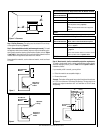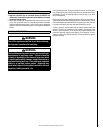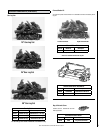
5
This heater shall not be installed in a confined space or unusually tight
construction unless provisions are provided for adequate combustion
and ventilation air. The heater may be located in unusually tight construc-
tion provided the space is unconfined, or if confined, is provided with two
permanent openings communicating directly with an additional room(s)
of sufficient volume so that the combined volume of all connected spaces
meets the criteria for an unconfined space, (National Fuel Gas Code
NFPA 54 / ANSI Z223.1 (latest edition), Section on Air for Combustion
and Ventilation. Generally 50 ft
3
per 1,000 BTU input of all operating
appliances in the space.
The National Fuel Gas Code, ANSI Z223.1/NFPA 54-latest edition defines
a confined space as a space whose volume is less than 50 cubic feet per
1000 Btu per hour (4.8 m³ per kW) of the aggregate input rating of all
appliances installed in that space and an unconfined space as a space
whose volume is not less than 50 cubic feet per 1000 Btu per hour (4.8
m³ per kW) of the aggregate input rating of all appliances installed in
that space.
Rooms communicating directly with the space in which the appliances
are installed, through openings not furnished with doors, are considered
a part of the unconfined space.
Unusually tight construction is defined as construction where:
a. Wall and ceilings exposed to the outside atmosphere have a continu-
ous water vapor retarder with a rating or one perm (6 x 10-11 kg per
pa-sec-m2) or less with openings gasketed or sealed;
b. Weather stripping has been added on operable windows and doors;
and
c. Caulking or sealants are applied to areas such as joints around window
and door frames, between sole plates and floors, between wall-ceiling
joints, between wall panels, at penetrations for plumbing, electrical,
and gas lines, and at other openings.
Use the following equations to determine if you have a confined or
unconfined space.
1. Determine the volume of space — ft
3
.
Length x Width x Height = _____ ft
3
(Include adjoining rooms with doorless passageways or ventilation grills
between rooms).
Example: 24' (L) x 16' (W) x 8' (H) = 3072 ft
3
2. Divide the volume of space by 50 ft
3
to determine the maximum BTU/Hr
the space can support.
(volume of space – ft
3
) / 50 ft
3
= (Maximum BTU/Hr the space can
support)
Example: 3072 ft
3
/ 50 ft
3
= 61.44
or 61,440 BTU/Hr the space can support.
3. Add the BTU/Hr of all the fuel burning appliances in the space.
Vent-Free Heater ________ BTU/Hr
Gas Appliance #1* ________ BTU/Hr
Gas Appliance #2 +________ BTU/Hr
Total =________ BTU/Hr
Example:
Vent-Free Heater 36,000 BTU/Hr
Gas Appliance #1 35,000 BTU/Hr
(water heater)
Total = 71,000 BTU/Hr
* Do not include Direct-Vent Gas Appliances. Direct-Vent is sealed
combustion and draws combustion air from the outdoors.
COMBUSTION AND VENTILATION AIR
NEW YORK
Installation of these gas log heaters are approved in the state of New York
and are prohibited in New York City.
MASSACHUSETTS REQUIREMENTS
These fireplaces are approved for installation in the US state of Massa-
chusetts if the following additional requirements are met:
• Unvented Room Heaters shall be installed in accordance with 527
CMR 30.00 and 248 CMR 3.00 through 7.00:
• Installation and repair must be done by a plumber or gas fitter licensed
in the Commonwealth of Massachusetts
• The flexible gas line connector used shall not exceed 36 inches (92
centimeters) in length.
• The individual manual shut-off must be a T-handle type valve.
• Vent-Free appliances may NOT be installed in bedrooms or bath-
rooms.
• A working smoke detector must be installed in the area where vent-
free appliances are installed.
Seller of unvented propane or natural gas-fired supplemental room
heaters shall provide to each purchaser a copy of 527 CMR 30 upon
sale of the unit.


















